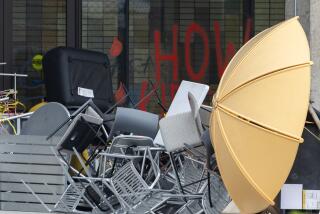Un-Occupying L.A.
- Share via
After weeks of uncertainty about when and how the endgame would play out, the Occupy L.A. eviction was the best possible outcome, a tribute to Mayor Antonio Villaraigosa, Chief Charlie Beck and a disciplined, creative Los Angeles Police Department. Clearly, the Monday morning dress rehearsal had provided police and protesters ample preparation for the real thing, and both sides showed admirable restraint in the unavoidable confrontation that occurred in the early hours of Wednesday.
This was not merely a case of routine police work well done. What transpired on the City Hall turf, ragged after hundreds of campers had slept there, was a thoughtfully planned and calibrated police show of force against a complicated act of civil disobedience. The result: a peaceful conclusion to what could have ended in violence. No rubber bullets, pepper spray or tear gas were used. Batons were brandished but not used to strike people, according to police. (An Occupier in a treehouse was bean-bagged to bring him down.) No officers arrived on horseback.
There’s no question the police presence was deliberately intimidating. There were 1,400 officers on the scene and they arrested 292 people — a fraction of the demonstrators present, according to Cmdr. Andrew Smith.
Over the last two decades, the LAPD has transformed itself into a more sophisticated force, with a unit skilled at handling labor demonstrations. Still, the 2007 May Day melee that left demonstrators and journalists injured was a memorable setback for the department, even after it was well along the road to reform and had changed chiefs three times.
Police officials never intended to evict the occupiers on Monday morning, only to announce the closure of the City Hall grounds — and they wisely hung back, using the time to assess who were simply agitators and who were truly protesters and their patterns of movement. Meanwhile, Occupy L.A. organizers had days to prepare participants for a cooperative confrontation and to remind anyone within hearing range of their tag-team public address system that their movement was not about violence.
In the end, it was something of a triumph of both policing and protesting. Indeed, the subsequent news conference featured the mayor and his chief congratulating one another on a job well done. What a striking contrast to the Los Angeles of 1992, as rioting erupted after the verdicts in the Rodney G. King beating trial. Mayor Tom Bradley wasn’t even on speaking terms with Chief Daryl F. Gates, and the city burned. This week’s episode was no riot; it was contained and occurred, after all, across the street from police headquarters. But communication between the mayor and the chief and well-planned, well-executed police work saved this city another heartache.
More to Read
A cure for the common opinion
Get thought-provoking perspectives with our weekly newsletter.
You may occasionally receive promotional content from the Los Angeles Times.










